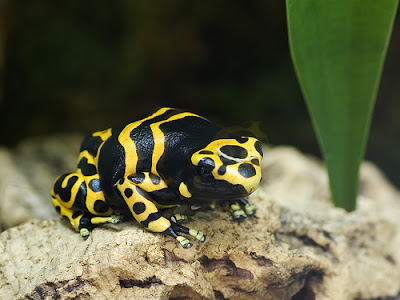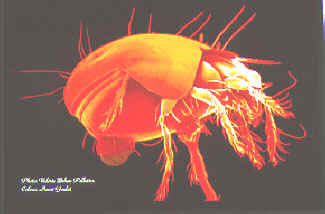A team of Florida International University zoologists studying poison arrow frogs in South America have identified the source of the colorful critters' toxicity. Researchers have long known that the amphibians do not produce the toxic compounds, alkaloids, themselves, but were uncertain of their origins. The FIU team discovered that the frogs were eating tiny oribatid mites that are abundant in decaying plant matter. Analysis of the mites determined over 80 types of alkaloids present in their tiny bodies, explaining the source of the frogs' defense.
Come on... just one quick taste... all the kids are doing it... Yellow-banded Dart Frog, Dedrobated leucomelas

Magically delicious. Oribatid Mite
Add to:  Slashdot
Slashdot  del.icio.us
del.icio.us
 reddit
reddit
 newsvine
newsvine
 Y! MyWeb
Y! MyWeb
 Slashdot
Slashdot  del.icio.us
del.icio.us  reddit
reddit  newsvine
newsvine  Y! MyWeb
Y! MyWeb- Log in to post comments
More like this
tags: Seattle Washington, Biology Department Greenhouse, University of Washington, poison dart frogs, Dendrobates, Dendrobatidae
Captive-bred Dyeing Poison Dart frog, Dendrobates tinctorius, from the Guianas of northeastern South America.
Image: GrrlScientist 29 September 2008 [larger view].…
The Japanese public watched in fascination last month as the first manta ray birth in captivity was broadcast nationwide from the Okinawa Churaumi Aquarium. Adult manta rays are large with ,Aeuwingspans,Aeu up to 25,Aeo across. However, baby manta rays are hardly guppies, emerging from their mother…
A relative of the starfish, crinoids are neither abundant nor well understood. Also known as "sea lilies" or "feather stars" the strange creatures consist of a mouthpart, feeding arms and generally have a stem that connects them to the sea floor. Scientists have long known that crinoids were…
Rooks in Exeter, England have discovered a unique health benefit to cigarettes that may just be enough to save the embattled industry. Commuters observed the rooks at St. David's train station fumigating their feathers with cigarette smoke. Swooping down to snatch up lit cigarette butts, the rooks…